



|
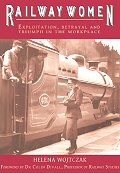
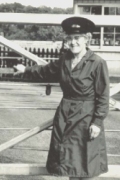
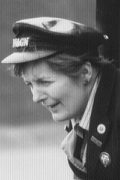

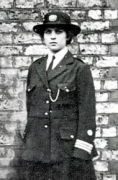

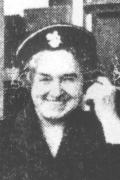
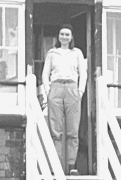

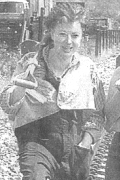
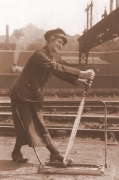
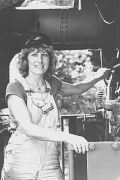
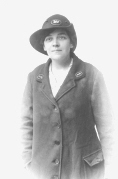
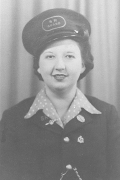
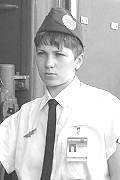
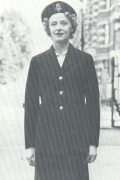
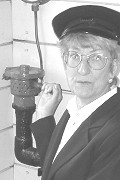




|
REVIEWS of "RAILWAYWOMEN"PAGE 2 page 1
NICOLA FOX'S REVIEW OF "RAILWAYWOMEN"
... AND THE AUTHOR'S RESPONSE
FROM "ORAL HISTORY", AUTUMN 2006
"In the postscript to this book, Helena Wojtczak describes an incident that took place during her research, when a fellow researcher at the National Archives informed her that women had not worked in the railway industry 'until recently' (p 371). An intention of the author is to challenge this common assumption that women's contribution to life on the railways since their inception has been negligible. The book is a detailed and wide-ranging account of the history of women railway workers from the beginning of the railways themselves, until the present day. This is the first time that such a comprehensive and unbroken history of women railway workers has been attempted. Previous studies of railway workers seem to either ignore the contribution of women entirely, or focus only on their efforts in the industry during both world wars.
The book offers a chronological appraisal of women's employment on the railways, beginning with the first, uncertain evidence of female workers in the railways' earliest days, to the employment of women in the highest echelons of the privatised industry of the 1990s. The opening chapter examines the surprisingly varied positions in the industry occupied by women in the nineteenth century. Apart from the more traditional employment as cleaners and caterers, we learn that women were working as crossing keepers and station mistresses, booking clerks and ticket sorters even by the 1870s. However, the majority of railway work was uniquely the preserve of men. Generally, women were paid only half to two-thirds of the wages of men, and were barred from joining the National Union of Railwaymen.
The contribution of women to the railways during both world wars is given considerable attention, but this by no means dominates the book. For the first time, women were allowed - indeed required - to do traditional 'men's jobs' such as shunting, signalling and maintaining infrastructure and equipment. By the end of the Second World War, the only jobs that eluded them were on the footplate of a steam engine. But these chapters are not simply dry accounts of the types of work that women attempted. The author considers their welfare and working conditions, the inequalities of pay, the choice of clothing available, and the social opportunities opened up by working on the railway. A unique collection of photographs aptly illustrates these many varied tasks performed by women during the wars.
It is surprising to learn that some of the most virulent and vicious anti-women prejudice occurred in relatively recent times. Sexual harassment in the decades after the Second World War was rife, and a common tactic was to post offensive graffiti about women in mess-rooms and on train cab walls. One train driver as recently as 1985 refused to believe that the woman signaller he encountered was actually the signaller on duty (p 279). British Rail's newspaper Railnews only seemed to encourage such an attitude. The author is scathing in her condemnation of this publication, when even as late as the 1970s its journalists insisted on referring to railway women as 'pretty girls', and a reporter asked a female member of a Sealink gang how she coped with her housework. However, Wojtczak complains that the accompanying photographs of women always showed a considerable amount of bare leg, while failing to concede that these women were presumably not forced to pose in such a manner.
The author makes no secret of her distrust of secondary sources, the established literature of the genre of railway workers, as this, 'allows others to filter information through their personal prejudices and bias' (p 372). Consequently, the book is a result of meticulous and painstaking research from a vast array of diverse and innovative primary sources. Other authors' railway studies appear very infrequently in her references. From newspapers to railway companies' journals, staff newsletters to Hansard references, and Union conference minutes to Pathé public information films, it seems that nothing has been overlooked. The War Cabinet Committee papers from 1919 expose how the National Union of Railwaymen claimed that prior to 1914, railway companies did not engage women, when in fact over 13,000 were employed (p 36). The Great Eastern Railway magazine from November 1916 reveals the story of five stewardesses whose GER steam ship was captured by the enemy, and who were held prisoner in Belgium. It was only the intervention of the Secretary of State for Foreign Affairs that led to their repatriation (p 63).
The many references to personal testimony in the form of letters and interviews with former railway women themselves also add appeal to this book. Whenever she describes a particular aspect of railway work, the author is always at pains to give examples of individual women who performed that role by name and age. Numerous quotations from women with first hand experience provide context, interest, and occasionally humour. A catering assistant at Ashford during the Second World War recalls how her customers, in true British fashion, demanded tea even though a bomb had just blown out the back of the building (p 149). An account of mid-nineteenth century crossing keeper 'Red Ellen' reveals how enginemen came to her assistance when her pig died. She was persuaded to keep hold of the carcass, and in a day or two a train passed her crossing with a consignment of live pigs. The enterprising driver stopped the train, and swapped Ellen's dead pig for a live one from the train (p 12).
The book concludes with individual testimonies from ten women who work or have worked on the railways in recent years, including the personal history of the author. She became the railways' first female guard in 1977, and encountered much prejudice and hostility from male colleagues and BR management, despite growing to love the job. Her railway career ended acrimoniously, as she was removed from guard's duties on medical grounds, but while a male colleague with less service in a similar situation was immediately found a role as a clerk, she was informed that the only vacancy for her was as a carriage cleaner. Understandably, she 'burned with resentment at the injustice of it all' (p 349). This resentment has clearly spilled over into her work, as the greatest downfall of this book is the apparently already decided agenda with which she chooses to write.
Her determination to illustrate and bemoan the subjection and abuse suffered by women on the railways since their beginnings leaps out at the reader from every page. Her indignation at their treatment throughout the ages is shouted from the rooftops. Of course we should not underestimate the betrayal and humiliations that countless of these women have suffered at the hands of their male colleagues, the Unions and management. To give one example, when the British Transport Commission announced in 1955 that it would grant equal pay to women in technical and clerical grades, it was later revealed that because of the exclusions they imposed, only 24 per cent of women in these grades actually qualified for it (p 258). However, she makes no allowances for the differences of thought and opinion compared with our own that were mainstream in past societies. Describing Edwardian society as 'sexist' (p 45) does not really deal with the complexities involved in analysing and understanding a time gone by. Nor does she place the experiences of women on the railways in the context of wider society. She complains that 'women were on the margins of railway life' (p 5), without acknowledging that this may well have been the case in most other industries as well. This gives the unfair impression that the railway was a particularly backward and unusually misogynist institution.
Railwaymen as a species come off very badly in this book. She writes as if there was a deliberate and sustained conspiracy at work on the railways determined to root out and destroy all women railway workers. All too often she makes rather sweeping statements about railwaymen, as if they were a united body all thinking the same thing, without any specific evidence to illustrate this point. For example, she argues that the suggestion that women might have attempted certain railway work 'would have reduced railwaymen to helpless mirth' (p 11). Would it? All railwaymen? How do we know? Another tactic is to quote a particular anti-women comment by an individual, and then surreptitiously imply that all men felt the same. The writer of a letter to the Railway Review claims that when female carriage cleaners saw a mouse they would 'disappear', but the author uses this as an excuse to claim that 'some men' objected to women becoming carriage cleaners (p 239).
This bias also works the other way where women are concerned. The reader is left with the understanding that every woman employed on the railways since records began was without exception an exemplary worker, brave, determined, loyal and true. It is a shame that such a pro-women, and anti-male prejudices should permeate throughout the entire book. Such a blatantly outraged attitude to the, albeit undeniable, injustices suffered by women, has the unfortunate and unintentional effect of making the reader begin to root for the railwaymen, whose individual voices have been denied in such an unequivocal denouncement of their kind."
Nicola Fox
Author Helena Wojtczak responds to Nicola Fox's review.
Dear Editor
I would like to thank Nicola Fox for reading my book 'Railwaywomen' and for the impartial comments which comprise the bulk of her review. Towards the end, however, her scathing criticism includes a number of factual errors and besmirches my reputation.
1. Fox opined that 'the greatest downfall of this book is the apparently already decided agenda with which [Wojtczak] chooses to write.' She claimed that my agenda comprised of being 'anti-male'. I had no pre-planned agenda. My sole objective was to research the history of women working on the railways and to report my findings - whatever they might be - with integrity and fairness and without suppressing, exaggerating or distorting any evidence. The book was compiled entirely from real events, and from documents, newspapers, minutes and magazines (almost entirely written by men) and from the first-hand testimony of former railwaywomen of all ages. This research - which Fox herself described as 'meticulous and painstaking' - uncovered 175 years of attitudes, words and deeds that were transparently and consistently anti-female. Writing up these findings does not make an author 'anti-male'.
2. Fox wrote: 'Describing Edwardian society as "sexist" does not really deal with the complexities involved in analysing and understanding a time gone by.' To have deviated into a complex, sociological and psychological analysis of gender relations over 175 years (all eras, not just Edwardian, would have to be dealt with) would have been inappropriate and doubled the length of the book.
3. Fox asserted: '[Wojtczak] makes no allowances for the difference of thought and opinion compared with our own that were mainstream in past societies.' But I do - several times, e.g. 'One needs to place [the railway unions'] actions into historical, social and economic context … It seems unrealistic to expect [railwaymen] to hold views on women workers that were wildly different from those of their peers, their bosses and their counterparts in other industries and unions' (p366).
4. Fox wrote: '[Wojtczak] complains that "women were on the margins of railway life" without acknowledging that this may well have been the case in most other industries as well'. But I do acknowledge this, several times: e.g. '[Women's] utilisation in war work was typical of how women were treated in other male-dominated workplaces'. 'Railway managers … and every other industrial employer exploited the poor bargaining position that women held in the labour market' (p364).
5. Fox claimed that I 'give the unfair impression that the railway was a particularly backward and misogynist institution'. I was not being unfair; the evidence proves that it was, e.g. as late as 1974 railwaymen protested against the proposed recruitment of women as train guards, whereas women have worked as bus conductresses (a similar role) since 1940.
6. Fox accused me of writing 'as if there was a deliberate and sustained conspiracy … to root out and destroy all women railway workers'. My book includes reports by male journalists and union officials about railwaymen's attempts to root out and oust women from certain jobs; however I did not imply any conspiracy nor any attempt to destroy women.
7. Fox claimed that I make 'sweeping statements about railwaymen as if they were a united body all thinking the same thing', and that I 'quote a particular anti-women comment by an individual, and then surreptitiously imply that all men felt the same'. Not so; I was careful to explain that men's stance towards women varied enormously, e.g. 'Railwaymen's reactions to women war-workers encompassed a wide range of attitudes, from camaraderie and friendship through flirtation and romance to prejudice, acrimony and resentment' (p188).
8. Fox claimed that I lead the reader to believe that 'every woman employed on the railways since records began was without exception an exemplary worker, brave, determined, loyal and true'. No so; I cite cases in which women received stolen property (p13), misappropriated money (p49) stole goods (p187), caused a fatal train crash (p242), caused the destruction of level crossing gates (p244) and punched a colleague (p309). I cite women who were sacked for immorality (p121), for sexual harassment (p294) and for being drunk in charge of a signalbox (p232).
9. Fox claimed that 'railwaymen's individual voices have been denied'. In fact their voices, opinions and attitudes are given extensive coverage throughout the book, both in direct quotes and in minutes of union meetings, press cuttings and oral evidence from railwaywomen.
10. Fox objected to my 'blatantly outraged attitude to the, albeit undeniable, injustices suffered by women' and yet, earlier, she herself expressed similar outrage, describing men's treatment of railwaywomen as 'virulent and vicious anti-women prejudice'.
11. Fox asserted that my 'denouncement' of railwaymen is 'unequivocal' (i.e. absolute) and yet the book contains countless examples of men's goodwill, not only in quotes from dozens of railwaywomen, but in my own narrative, e.g. '[Women] made some stalwart friends among railwaymen. Some behaved like old fashioned gentlemen … others acted like fathers or brothers and defended women from unfair criticism. A few … were very vocal in their support of women's liberation …Women found great comradeship' (p288). 'There were romances, marriages and extramarital affairs. However, platonic friendships were the most common …
a source of much affection and joviality on both sides' (p191). 'My fellow trainees were friendly and flirtatious' (p340 - from my own memoirs!)
"Railwaywomen" has received 35 reviews, 25 of them from men. Fox alone perceives my book as 'anti-male'.
Yours sincerely
Helena Wojtczak
(pictured left)
|

















































